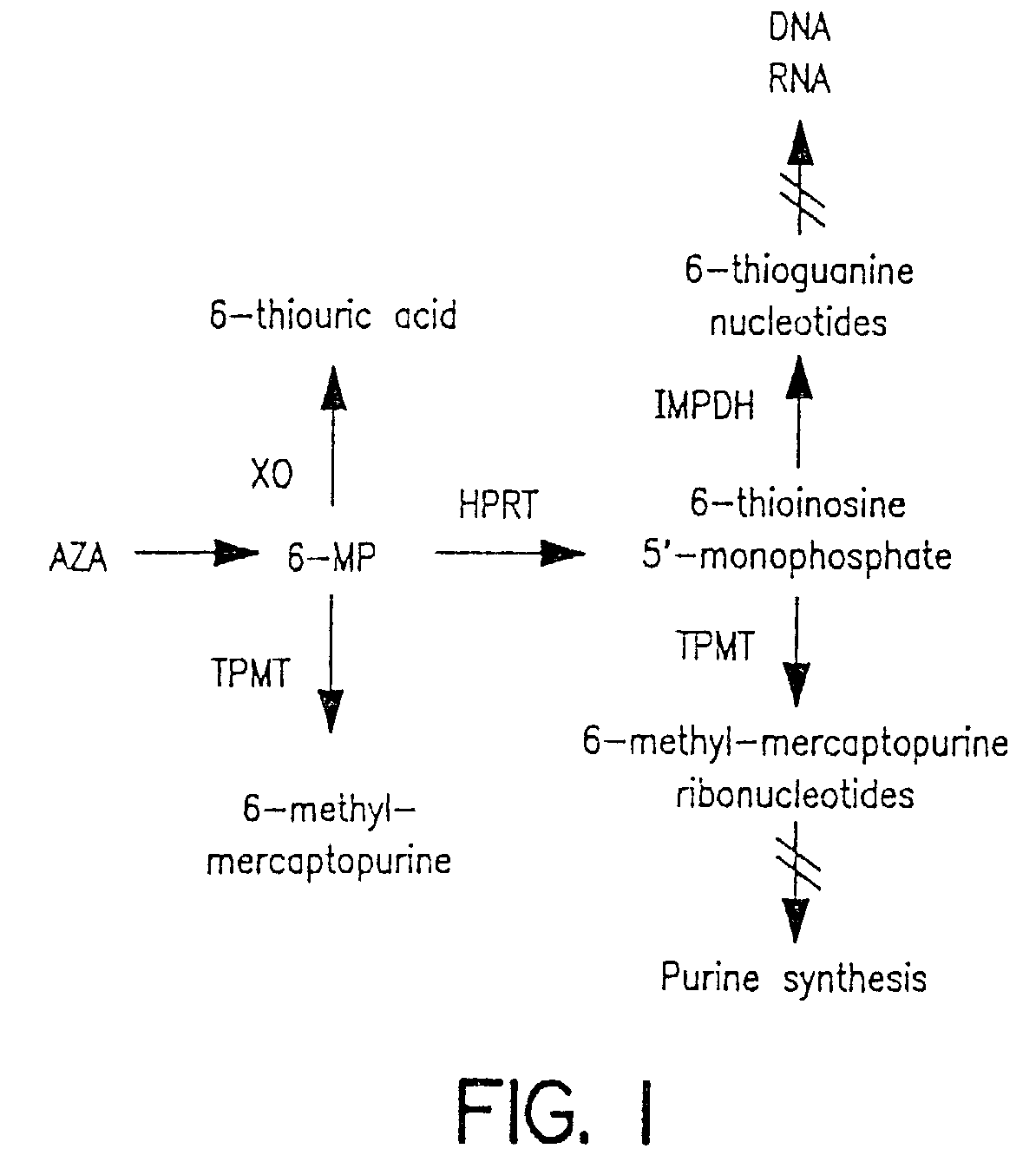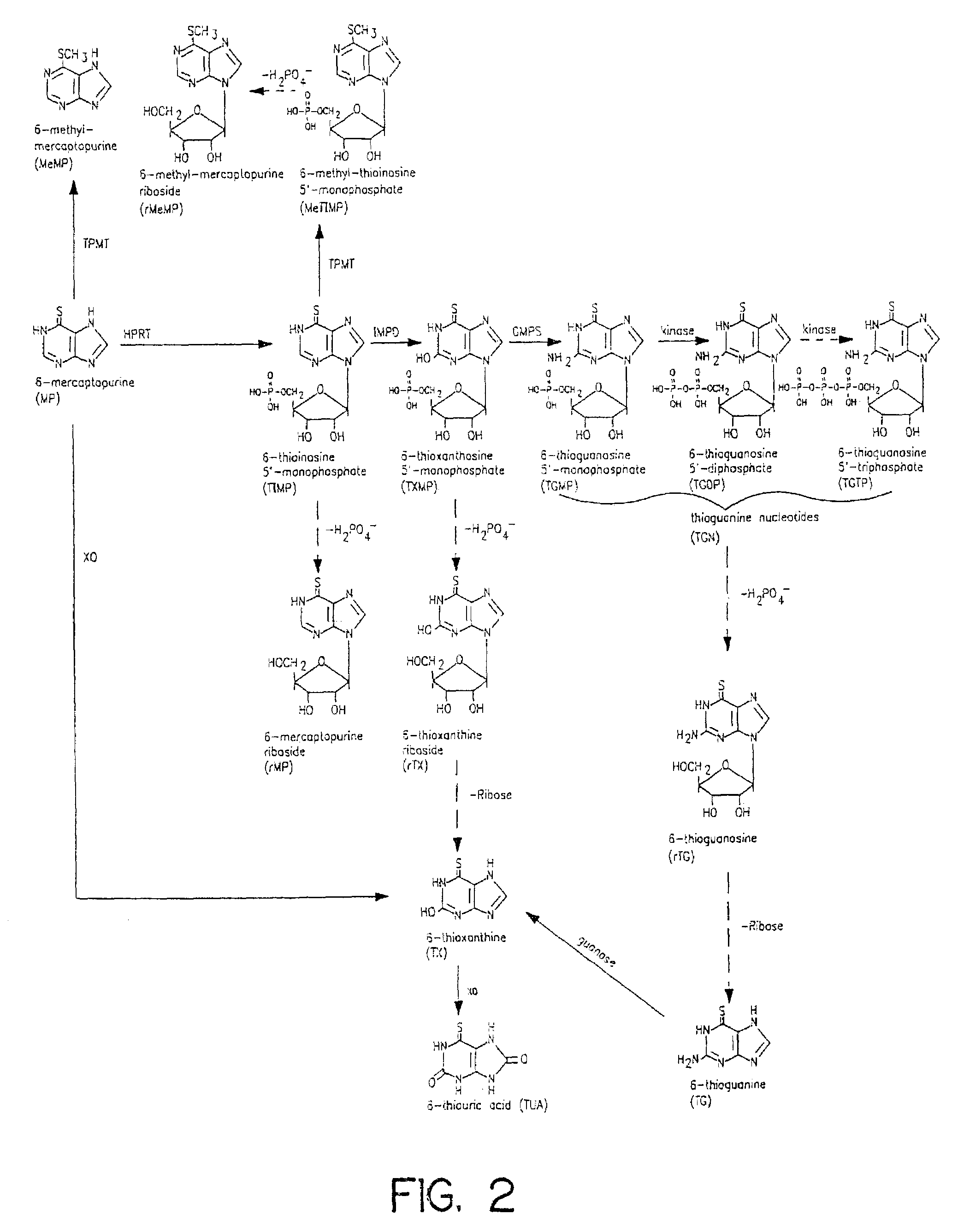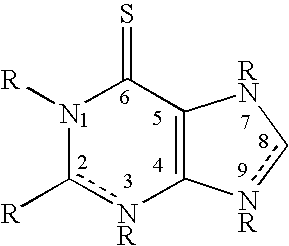Method of determining thiopurine methyltransferase activity
a technology of methyltransferase and thiopurine, which is applied in the field of thiopurine drugs, can solve the problems of hematopoietic toxicity that cannot be tolerated, and many physicians are reluctant to treat patients with azathioprine/6-mercaptopurine therapy
- Summary
- Abstract
- Description
- Claims
- Application Information
AI Technical Summary
Benefits of technology
Problems solved by technology
Method used
Image
Examples
example i
Qualitative Determination of Thiopurine Methyltransferase Enzyme Activity Levels in Human Red Blood Cells
[0030]This example describes quantitative determination of thiopurine methyltransferase (TPMT) activity using 6-thioguanine as a substrate.
A. Blood Sample Preparation
[0031]Whole blood samples were washed in normal saline, and the hemoglobin count determined prior to freezing. Briefly, blood samples were collected in ethylene diamine tetraacetic acid (EDTA), and the EDTA-treated whole blood centrifuged for 3 minutes at 3500 rpm at 10 C in a tabletop centrifuge (Beckman, Fullerton, Calif.: Model #TJ-6R). Plasma was examined for hemolysis, and sample was rejected if hemolysis was detected. After removing the plasma, packed cells were washed one time with an equal volume of 0.9% saline and centrifuged as described above. A hemoglobin count was determined using a Coulter ONYX cell counter. After counting, the washed packed red blood cells (RBCs) were diluted 1:5 with 0.02 M phosphate...
example ii
Correlation of TPMT Activity with TPMT Genotype
[0040]This example demonstrates that the methods of the invention for determining TPMT activity produce results that correlate with TPMT genotyping.
[0041]Previous studies of various ethnic populations have shown that roughly 89% of individuals express wild type (high) TPMT activity, while about 11% express intermediate activity and less than 1% (approximately 0.3%) express very low or undetectable TPMT activity. TPMT activity levels assayed using perchloric acid precipitation followed by HPLC and fluorescence detection as described in Example I were correlated to several TPMT genotype classes: TPMT*2-G238C in exon 5.; TPMT*3A-G460A in exon 7, and TPMT*3-A719G in exon 10. To a large degree, these three mutations determine TPMT enzyme activity levels in humans.
[0042]TPMT enzyme units and TPMT genotypes were measured for 44 individuals with a wild type genotype, 6 heterozygous individuals, and 1 homozygote low individual, with red cell lys...
example iii
Survey of Acids for Protein Precipitation
[0049]This example describes the use of several different acids for the precipitation of proteinaceous material from samples containing 6-methylthioguanine.
[0050]A calibration standard curve and high controls were prepared as described in Example I. Both the standard curve and controls contained 6-methyl thioguanine (6-mTG), the product of the reaction catalyzed by TPMT, making the reaction portion of the protocol unnecessary. To the standard curve and one set of tubes, 11 M perchloric acid (PCA) was added. In place of the perchloric acid, one of the following acids was added to each set of samples: 17 M acetic acid (glacial) to a final concentration of 2.83 M; 16 M nitric acid (HNO3) to a final concentration of 2.67 M; 15 M phosphoric acid (H3PO4) to a final concentration of 2.5 M; 18 M sulfuric acid (H2SO4) to a final concentration of 3 M, or 6 M trichloroacetic acid (TCA) to a final concentration of 1 M. Samples were then processed and ana...
PUM
| Property | Measurement | Unit |
|---|---|---|
| pH | aaaaa | aaaaa |
| flow rate | aaaaa | aaaaa |
| emission wavelength | aaaaa | aaaaa |
Abstract
Description
Claims
Application Information
 Login to View More
Login to View More - R&D
- Intellectual Property
- Life Sciences
- Materials
- Tech Scout
- Unparalleled Data Quality
- Higher Quality Content
- 60% Fewer Hallucinations
Browse by: Latest US Patents, China's latest patents, Technical Efficacy Thesaurus, Application Domain, Technology Topic, Popular Technical Reports.
© 2025 PatSnap. All rights reserved.Legal|Privacy policy|Modern Slavery Act Transparency Statement|Sitemap|About US| Contact US: help@patsnap.com



